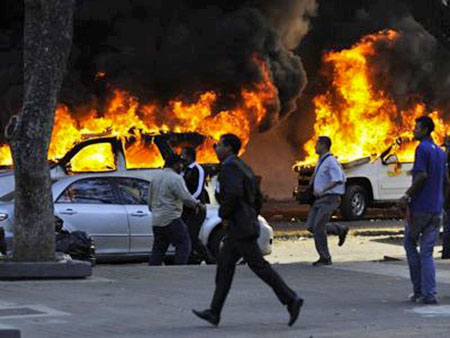|
from VoltaireNetwork Website
Forty years ago that scenario worked:
In Venezuela the Chilean scenario did not work.
The conspirators, following the instructions of their overseers from the CIA, planned to provoke mass discontent. They tried everything: an artificial shortage of staple commodities, sabotage on public transportation, attacks on government agencies, and barricading of major highways and roads to residential areas.
Everywhere over the cities - as an alarming sign of instability - there hung black smoke from burning tires (an eloquent echo of the Kiev Maidan)… All of this was synchronized and well organized.
Nicolas Maduro and the Bolivarian government
stood fast. And President
Obama, who has suffered defeat on
practically all fronts in the fight for U.S. hegemony, has authorized the
toughening of operations for influencing the Bolivarian regime…
When Leininger’s apartment was searched, they found a secret cache of firearms: three rifles (one with a telescopic sight and a silencer), two pistols, a sizeable ammunition stockpile and several suits of camouflage. The American was suspected of planning terrorist acts.
An investigation is now in progress, and the
facts of the use of these weapons by militant groups of the radical
opposition are being established.
They say that Leininger is by nature not inclined to violence and risky undertakings, to say nothing of using weapons. If something of the sort did take place, it was only because Leininger is "not completely well and has a persecution mania".
This last theory, which supposedly came from his
mother, is meant to explain why weapons were found in the American’s
possession.
According to investigators, the CIA recruits terrorists from around the world to work in Venezuela.
Venezuelan security agencies have been receiving information about the activities of CIA stations in Colombia, Honduras, Mexico, Panama and several other countries in transferring "controlled" fighters from drug cartels to Venezuela. It is sufficient to mention that some of the barricades in the period of the most intense uprisings of the radical opposition were controlled by Colombian narcotraficantes who are wanted by Interpol.
Photographs of the criminals among the
Venezuelan opposition activists made their way onto the Internet. However,
in such situations CIA agents have immunity in spite of the authority of
Interpol and the norms of international law.
Most of those killed were ordinary citizens. In the first stage of the terrorist operations for overthrowing the regime, the CIA mercenaries deliberately and consistently chose victims on both sides of the barricades (just as on the Kiev Maidan).
Their goal was to exacerbate the confrontation between supporters of the government and the opposition. In the practice of American intelligence, "slaughter statistics" are an important aspect of the sabotage war against the country selected for destabilization...
In the CIA propaganda campaign, the following thesis prevails:
In April and early May the statistics of attacks on functionaries of the ruling PSUV party and military and law enforcement officers rose abruptly.
Firearms were used in practically all these cases. Venezuelan Minister of Internal Affairs Miguel Rodriguez Torres has stated that in the new stage of sabotage operations the CIA has focused on "selective killings".
And targets are selected whose violent deaths will have maximal political repercussions:
Among the victims was prominent Bolivarian politician Eliezer Otaiza.
In the early years of Hugo Chavez’ administration he headed DISIP, the counterintelligence service (now Sebin).
Otaiza, who did not use security guards, was
ambushed by paramilitares on a deserted road, tortured and then
killed by shots in the back. In the opinion of a number of Latin American
analysts, Otaiza was secretly organizing resistance groups in Venezuela in
case of armed aggression from the U.S.
DIM agents identify and neutralize enemy agents in military divisions and protect strategically important sites in the country from sabotage. Thanks to the efficient operation of DIM, a group of air force generals who were planning an armed uprising against the government was recently uncovered.
The generals were at one time trained in the U.S., and after the victory of the Bolivarian revolution they maintained secret ties with employees of the military attaché office in the American embassy in Caracas.
DIM received signals about the activities of the
conspiring generals from young officers. Attempts had been made to recruit
them for anti-government activities, including organizing the escape of one
of the pilots on a Russian-built SU airplane.
Sebin employees were able to identify the leadership structure of the conspiracy, record the content of conversations between the Venezuelan conspirators and their overseers from the CIA, and ascertain channels for importing weapons and explosives into the country and sources of financing.
In some confiscated laptops they found lists of Chavists slated for elimination.
Sebin has cleared opposition tent camps in
Caracas which, according to CIA plans, were to be transformed into
Venezuelan Maidans. During the operation, large amounts of money, weapons,
Molotov cocktails and drugs were found in the tents.
According to Venezuelan political scientists, the CIA could have used this data to prepare an attempt on Nicolas Maduro.
|

